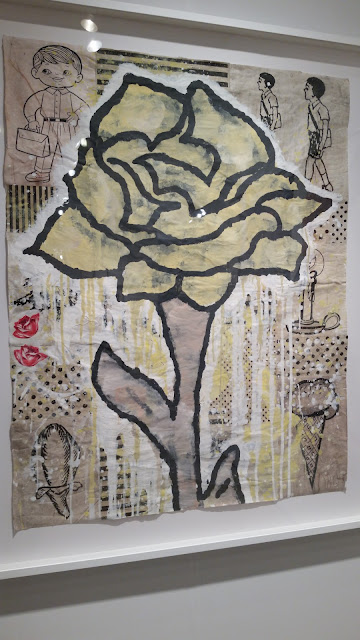1. This is the fifth year that the giant exhibition hall at the end of Chicago's Navy Pier has hosted the Expo Chicago art fair, and according to its organizers and PR people, it was the biggest and most successful of all, in terms of participating galleries, attendance, and sales.
2. I could not tell whether the impressive, shiny, well-produced art on display was any different from what I saw on the walls last year, or the year before that, or the year before that, or the year before that. But a couple of things with lots of texture and loose execution caught my eye, nevertheless:
 |
| Rose, Donald Baechler |
 |
Mica Painting (Sunflowers), Catherine Howe
|
3. The special projects, ranged around the sides of the hall, were dedicated to more experimental works created by exhibiting artists. I liked this piece by Cody Hudson:
 |
| Hold It Up to the Light, 2016 |
4. Why does anyone go to art fairs? It's about as much fun as going to Walmart. Yes, there is a lot of contemporary art in one place, but that's as much a minus as a plus. Even at the finest museums, aesthetic exhaustion sets in after an hour.
5. Not all of the special projects were well done. I admire the subject matter of these paintings based on the life of Harriet Tubman and the Underground Railroad, but not enough to avoid noticing that as oil paintings they were very poorly done:
 |
| Harriet Tubman En Route to Canada, Kimathi Donkor |
6. But then there might be a didactic piece that does have power, such as this series of prints by Samuel Levi Jones. He was inspired by reading about a Gerhard Richter installation from 1972, in which the German artist created a series of icons of Western culture, most of them conspicuously white and male. That was the year that the full set of the Encyclopedia Brittanica was published, with similar omissions. Jones took sheets of Britannica paper, and printed photos of iconic black figures on them, such as Gwendolyn Brooks and James Baldwin. The prints are so dark you have to strain hard to see the faces, which gradually emerge as shadow faces. Perhaps they make an obvious point about how many of us have to peer hard to see representations of black people, even culturally significant ones. But I thought the prints were physically beautiful, too, which leavened the political history lesson significantly:
 |
| 48 Portraits (underexposed) - detail, Samuel Levi Jones |
7. I went to the Venice Bienniale in 2013., only saw a fraction of the art on display despite spending almost all day at the Arsenale (the main exhibition grounds), and was too tired and art-ed out to want to go back. And that was in one of the most beautiful cities in the world, too. Again, who apart from rich buyers voluntarily subjects themselves to this?
8. On the other hand: I love art fairs when they produce a genuine surprise by an artist who is completely new to you, like this painting by a painter from Senegal, made entirely from inexpensive materials like acrylic, gouache, and pencil on cardboard:
 |
| The Decision Maker, Omar BA |
9. The best piece of all was this superb tunnel installation by Sabina Ott. There are video screens inside a labyrinth constructed from sculpted styrofoam, displaying quotations from the writings of Gertrude Stein. Ott's work is tactile and sensual, and literally immersive:
 |
| because the mountains were so high, Sabina Ott |
It was placed right next to the entrance, too, so in theory I could have just seen the best work there, then turned around and left without even subjecting myself to this:







